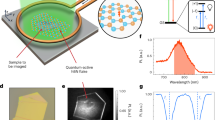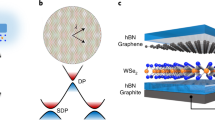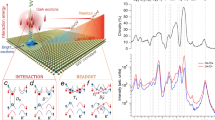Abstract
The chemical potential (μ) of an electron system is a fundamental property of a solid. A precise measurement of μ plays a crucial role in understanding the electron interaction and quantum states of matter. However, thermodynamics measurements in micro- and nanoscale samples are challenging because of the small sample volume and large background signals. Here we report an optical readout technique for μ of an arbitrary two-dimensional material. A monolayer semiconductor sensor is capacitively coupled to the sample. The sensor optical response determines a bias that fixes its chemical potential to the band edge and directly reads the μ value of the sample. We demonstrate the technique in AB-stacked MoTe2/WSe2 moiré bilayers. We obtain the μ value with a d.c. sensitivity of about 20 µeV Hz–1/2 and the compressibility and interlayer electric polarization using a.c. readout. The results reveal a correlated insulating state at a doping density of one hole per moiré unit cell, which evolves from a Mott insulator to a charge-transfer insulator with an increasing out-of-plane electric field. Furthermore, we image μ and quantify the spatial inhomogeneity of the sample. Our work opens the door for high-spatial-resolution and high-temporal-resolution measurements of the thermodynamic properties of two-dimensional quantum materials.
This is a preview of subscription content, access via your institution
Access options
Access Nature and 54 other Nature Portfolio journals
Get Nature+, our best-value online-access subscription
$29.99 / 30 days
cancel any time
Subscribe to this journal
Receive 12 print issues and online access
$209.00 per year
only $17.42 per issue
Buy this article
- Purchase on Springer Link
- Instant access to full article PDF
Prices may be subject to local taxes which are calculated during checkout




Similar content being viewed by others
Data availability
Source data are provided with this paper. Additional data that support the findings of this study are available from the corresponding authors upon reasonable request.
References
Smith, T. P., Goldberg, B. B., Stiles, P. J. & Heiblum, M. Direct measurement of the density of states of a two-dimensional electron gas. Phys. Rev. B 32, 2696–2699 (1985).
Kravchenko, S. V., Rinberg, D. A., Semenchinsky, S. G. & Pudalov, V. M. Evidence for the influence of electron-electron interaction on the chemical potential of the two-dimensional electron gas. Phys. Rev. B 42, 3741–3744 (1990).
Eisenstein, J. P., Pfeiffer, L. N. & West, K. W. Negative compressibility of interacting two-dimensional electron and quasiparticle gases. Phys. Rev. Lett. 68, 674–677 (1992).
Ashoori, R. C. et al. Single-electron capacitance spectroscopy of discrete quantum levels. Phys. Rev. Lett. 68, 3088–3091 (1992).
Eisenstein, J. P., Pfeiffer, L. N. & West, K. W. Compressibility of the two-dimensional electron gas: measurements of the zero-field exchange energy and fractional quantum Hall gap. Phys. Rev. B 50, 1760–1778 (1994).
Li, L. et al. Very large capacitance enhancement in a two-dimensional electron system. Science 332, 825–828 (2011).
Wei, Y. Y., Weis, J. V., Klitzing, K. & Eberl, K. Single-electron transistor as an electrometer measuring chemical potential variations. Appl. Phys. Lett. 71, 2514–2516 (1997).
Ilani, S., Yacoby, A., Mahalu, D. & Shtrikman, H. Unexpected behavior of the local compressibility near the B = 0 metal-insulator transition. Phys. Rev. Lett. 84, 3133–3136 (2000).
Martin, J. et al. Observation of electron–hole puddles in graphene using a scanning single-electron transistor. Nat. Phys. 4, 144–148 (2008).
Zondiner, U. et al. Cascade of phase transitions and Dirac revivals in magic-angle graphene. Nature 582, 203–208 (2020).
Kim, S. et al. Direct measurement of the Fermi energy in graphene using a double-layer heterostructure. Phys. Rev. Lett. 108, 116404 (2012).
Lee, K. et al. Chemical potential and quantum Hall ferromagnetism in bilayer graphene. Science 345, 58–61 (2014).
Yang, F. et al. Experimental determination of the energy per particle in partially filled Landau levels. Phys. Rev. Lett. 126, 156802 (2021).
Mak, K. F. & Shan, J. Photonics and optoelectronics of 2D semiconductor transition metal dichalcogenides. Nat. Photonics 10, 216–226 (2016).
Wang, G. et al. Colloquium: excitons in atomically thin transition metal dichalcogenides. Rev. Mod. Phys. 90, 021001 (2018).
MacDonald, A. H. Introduction to the physics of the quantum Hall regime. Preprint at https://arxiv.org/abs/cond-mat/9410047 (1994).
Kuntsevich, A. Y., Tupikov, Y. V., Pudalov, V. M. & Burmistrov, I. S. Strongly correlated two-dimensional plasma explored from entropy measurements. Nat. Commun. 6, 7298 (2015).
Hartman, N. et al. Direct entropy measurement in a mesoscopic quantum system. Nat. Phys. 14, 1083–1086 (2018).
Li, T. et al. Quantum anomalous Hall effect from intertwined moiré bands. Nature 600, 641–646 (2021).
Tao, Z. et al. Valley-coherent quantum anomalous hall state in AB-stacked MoTe2/WSe2 bilayers. Phys. Rev. X 14, 011004 (2024).
Zhao, W. et al. Realization of the Haldane Chern insulator in a moiré lattice. Nat. Phys. https://doi.org/10.1038/s41567-023-02284-0 (2024).
Zhao, W. et al. Gate-tunable heavy fermions in a moiré Kondo lattice. Nature 616, 61–65 (2023).
Zhang, Y., Devakul, T. & Fu, L. Spin-textured Chern bands in AB-stacked transition metal dichalcogenide bilayers. Proc. Natl Acad. Sci. USA 118, e2112673118 (2021).
Rademaker, L. Spin-orbit coupling in transition metal dichalcogenide heterobilayer flat bands. Phys. Rev. B 105, 195428 (2022).
Devakul, T. & Fu, L. Quantum anomalous Hall effect from inverted charge transfer gap. Phys. Rev. 12, 021031 (2022).
Pan, H., Xie, M., Wu, F. & Das Sarma, S. Topological phases in AB-stacked MoTe2/WSe2: Z2 topological insulators, Chern insulators, and topological charge density waves. Phys. Rev. Lett. 129, 056804 (2022).
Wang, L. et al. One-dimensional electrical contact to a two-dimensional material. Science 342, 614–617 (2013).
Sidler, M. et al. Fermi polaron-polaritons in charge-tunable atomically thin semiconductors. Nat. Phys. 13, 255–261 (2017).
Li, T. et al. Charge-order-enhanced capacitance in semiconductor moiré superlattices. Nat. Nanotechnol. 16, 1068–1072 (2021).
Xu, Y. et al. Correlated insulating states at fractional fillings of moiré superlattices. Nature 587, 214–218 (2020).
Mak, K. F. & Shan, J. Semiconductor moiré materials. Nat. Nanotechnol. 17, 686–695 (2022).
Li, T. et al. Continuous Mott transition in semiconductor moiré superlattices. Nature 597, 350–354 (2021).
Jin, C. et al. Stripe phases in WSe2/WS2 moiré superlattices. Nat. Mater. 20, 940–944 (2021).
Regan, E. C. et al. Mott and generalized Wigner crystal states in WSe2/WS2 moiré superlattices. Nature 579, 359–363 (2020).
Tang, Y. et al. Simulation of Hubbard model physics in WSe2/WS2 moiré superlattices. Nature 579, 353–358 (2020).
Back, P., Zeytinoglu, S., Ijaz, A., Kroner, M. & Imamoğlu, A. Realization of an electrically tunable narrow-bandwidth atomically thin mirror using monolayer MoSe2. Phys. Rev. Lett. 120, 037401 (2018).
Scuri, G. et al. Large excitonic reflectivity of monolayer MoSe2 encapsulated in hexagonal boron nitride. Phys. Rev. Lett. 120, 037402 (2018).
Wang, Z., Chiu, Y.-H., Honz, K., Mak, K. F. & Shan, J. Electrical tuning of interlayer exciton gases in WSe2 bilayers. Nano Lett. 18, 137–143 (2018).
Acknowledgements
We thank A. Pierce and P. Knüppel for helpful suggestions on the a.c. measurements. This work was partially supported through the Air Force Office of Scientific Research MURI under award no. FA9550-18-1-0480 (optical imaging of chemical potential), the National Science Foundation Grant DMR-2114535 (sensor design) and the Cornell University Materials Research Science and Engineering Center DMR-1719875 (device fabrication). This work was also funded in part by the Gordon and Betty Moore Foundation (grant no. GBMF11563; https://doi.org/10.37807/GBMF11563) and performed in part at the Cornell NanoScale Facility, an NNCI member supported by the NSF grant NNCI-2025233. The growth of the hBN crystals was supported by the Elemental Strategy Initiative of the Ministry of Education, Culture, Sports, Science and Technology, Japan, and the Core Research for Evolutional Science and Technology programme of the Japan Science and Technology Agency (grant no. JPMJCR15F3).
Author information
Authors and Affiliations
Contributions
Z.X., Y.Z., B.S. and R.D. fabricated the devices. Z.X. and Y.Z. performed the measurements and analysed the data. K.W. and T.T. grew the bulk hBN crystals. Z.X., Y.Z., K.F.M. and J.S. designed the scientific objectives, oversaw the project and co-wrote the manuscript. All authors discussed the results and commented on the manuscript.
Corresponding authors
Ethics declarations
Competing interests
The authors declare no competing interests.
Peer review
Peer review information
Nature Photonics thanks Luis Balicas and the other, anonymous, reviewer(s) for their contribution to the peer review of this work.
Additional information
Publisher’s note Springer Nature remains neutral with regard to jurisdictional claims in published maps and institutional affiliations.
Extended data
Extended Data Fig. 1 Extracting capacitance lever arm.
To extract the capacitance lever arm, we kept the sample at charge neutrality and the sensor at the reference point (by tuning Vbg). The blue dots show the relation between Vs and Vbg when sample is tuned (by Vtg and Vs) such that \({(C}_{{tg}}{V}_{{tg}}+{C}_{s}{V}_{s})\) is kept constant; this gives \({V}_{{bg}}=\left(\frac{{C}_{s}}{{C}_{{bg}}}+1\right){V}_{s}+{\rm{constant}}\). We determine the ratio \(\frac{{d}_{{bg}}}{{d}_{s}}=\frac{{C}_{s}}{{C}_{{bg}}}=2.05\) by fitting the results to a linear dependence (red line).
Extended Data Fig. 2 Gate-dependent reflectance contrast spectrum of WSe2.
Bottom gate voltage dependence of the optical reflectance contrast spectrum that covers the WSe2 resonance from both the sensor and moiré. The WSe2 resonance in the moiré is redshifted from that in the sensor by about 40–50 meV; the substantial redshift allows us to perform chemical potential sensing by a monolayer WSe2 sensor.
Extended Data Fig. 3 Reproducible results from another device.
a–c, Filling factor dependence of the hole chemical potential in AB-stacked MoTe2/WSe2 moiré bilayer at E=0.59 V/nm (a), 0.65 V/nm (b) and 0.70 V/nm (c). The chemical potential peak near ν=0 marks the onset of hole doping. The chemical potential jumps at ν=1 corresponds to an incompressible state. The system is a Mott insulator (a), charge-transfer insulator (b) and a semimetal (c) at ν=1. d, Filling factor dependence of \({\left(\frac{\partial \mu }{\partial E}\right)}_{\nu }\) at E=0.59 V/nm (blue) and 0.65 V/nm (red). A sharp sign change at ν=1 is observed only for the charge-transfer insulator at E=0.65 V/nm. e, Filling factor dependence of the interlayer electric polarization per moiré unit cell (obtained from integrating the data in d) at the same electric fields as in d. f, Electric field dependence of the ν=1 charge gap. Whereas the charge gap is independent of the electric field for the Mott insulator at E ≲ 0.625 V/nm, it decreases monotonically with electric field for the charge transfer insulator at \(E\) \(\gtrsim\) \(0.625\) V/nm.
Extended Data Fig. 4 Spatial resolution.
a, Reflection contrast image at the neutral exciton resonance of the WSe2 sensor. The bright region is the region of interest where the sample covered by the sensor. b, Inset: Linecut of reflectance count difference across a sharp sensor edge (taken at the green line in a). Main panel: Spatial derivative of the data in the inset (data points) and the corresponding Gaussian fit (solid line). The spatial resolution, as determined by twice of the standard deviation of the Gaussian fit, is about 1 um.
Extended Data Fig. 5 Correlation between the charge gap size, the moiré density and the critical electric field.
a, Correlation between the Mott gap size (at E=0.56 V/nm) and the moiré density as determined from the spatial maps in Fig. 4d, e in the main text. No obvious correlation is observed. b, Correlation between the Mott gap size and the critical electric field as determined from the spatial maps in Fig. 4e, f in the main text. A negative correlation is observed as shown by the linear fit.
Extended Data Fig. 6 Extraction of μ in imaging experiment.
a, b, Examples of extracting μ (at E=0.56 V/nm) at the representative pixel ‘R’ (a) and at a different sample location (b). The black curves are the spatial dependent characteristic response curves. At each ν and E, we kept ‘R’ at the set point through a feedback loop; the reflection count at each pixel was recorded (red dots). We then recorded the reflection counts at four additional bottom gate voltages near the set point (blue, orange and green dots). The characteristic response curves are then shifted horizontally to match to the five data points for each ν. The dashed lines correspond to 60 % reflectance contrast of the response curves. At each ν, we use the bottom gate voltage at the intersection of the dashed line and the response curve to obtain μ.
Extended Data Fig. 7 Device schematics.
Schematic dual-gated device structure with a sensor in between the sample and bottom gate. The active layers are separated by hBN dielectrics (not shown). The electrochemical potentials, chemical potentials, electric fields and doping densities are labeled. See Methods for details.
Source data
Source Data Fig. 1
Statistical source data.
Source Data Fig. 2
Statistical source data.
Source Data Fig. 3
Statistical source data.
Source Data Fig. 4
Statistical source data.
Rights and permissions
Springer Nature or its licensor (e.g. a society or other partner) holds exclusive rights to this article under a publishing agreement with the author(s) or other rightsholder(s); author self-archiving of the accepted manuscript version of this article is solely governed by the terms of such publishing agreement and applicable law.
About this article
Cite this article
Xia, Z., Zeng, Y., Shen, B. et al. Optical readout of the chemical potential of two-dimensional electrons. Nat. Photon. 18, 344–349 (2024). https://doi.org/10.1038/s41566-024-01377-3
Received:
Accepted:
Published:
Issue Date:
DOI: https://doi.org/10.1038/s41566-024-01377-3



